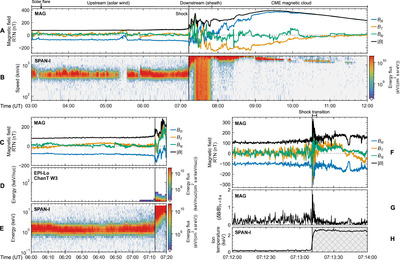Image Details

Caption: Figure 1.
Magnetic field and plasma measurements during the shock encounter. Panels (A) and (B) provide a 9 hr overview of the magnetic field and the 1D proton energy flux, capturing the preevent solar wind, the in situ shock passage, the following sheath region, and the initial portion of the associated CME ejecta. The SPAN-i data downstream of the shock do not accurately represent reality, as the flow is largely deflected away from the detector’s FOV. Panels (C)–(E) offer an 80 minute close-up leading to the shock arrival, showing variations in the bulk ion distribution as captured by the SPAN-i and EPI-Lo instruments. Finally, panels (F)–(H) focus on a 2 minute snapshot close to the shock transition, emphasizing fluctuations in the total magnetic field as well as the change in proton temperature. The downstream proton temperature is marked with hatching due to significant instrumental uncertainties.
Copyright and Terms & Conditions
© 2024. The Author(s). Published by the American Astronomical Society.












